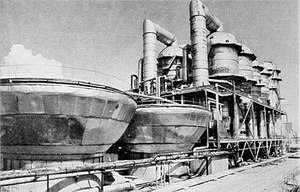
Back تحلية مياه Arabic বিলবণীকরণ Bengali/Bangla سازگارکردن CKB Odsolování Czech Meerwasserentsalzung German Αφαλάτωση Greek Desalination English Sensaligo Esperanto Desalinización Spanish Vee magestamine Estonian

Desalination means any process that removes the excess salt and other minerals from water in order to obtain fresh water suitable for animal consumption or irrigation. Most desalination is by distillation. Some is by reverse osmosis or other methods.
The main purpose is to make water for people to use. The salt is usually carried away as brine but in some places the solid salt is extracted.[1]
Desalination of brackish water is done in the United States in order to meet treaty obligations for river water entering Mexico. Several Middle Eastern countries have energy reserves so great that they use desalinated water for agriculture. Saudi Arabia's desalination plants account for about 24% of total world capacity. The world's largest desalination plant is the Jebel Ali Desalination Plant (Phase 2) in UAE. It uses multi-stage flash distillation, dual-purpose and it is capable of producing 300 million cubic meters of water per year.[2]
- ↑ Panagopoulos, Argyris; Haralambous, Katherine-Joanne; Loizidou, Maria (2019-11-25). "Desalination brine disposal methods and treatment technologies - A review". Science of the Total Environment. 693: 133545. doi:10.1016/j.scitotenv.2019.07.351. ISSN 0048-9697. PMID 31374511. S2CID 199387639.
- ↑ "Saline Water Conversion Corporation". Archived from the original on 2007-04-06. Retrieved 2007-04-14.